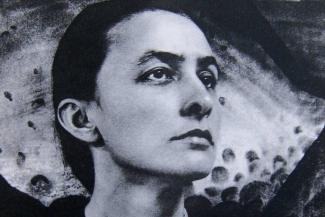Great Artists

Georgia O'Keeffe
Georgia O'Keeffe (1887-1986) was renowned for her paintings of enlarged flowers, New Mexican landscapes, and New York City skyscrapers. She has been called the "Mother of American modernism." She urged people to look closely at the world around them, to really see, empathize, and understand.
[Credit: "Oriental Poppies," oil on canvas by Georgia O'Keeffe, 1927, https://okeeffemuseum.org/]

O'Keeffe grew up on a farm in Wisconsin, the second of seven children, and became one of the most significant artists of the 20th century. She studied at the Art Institute of Chicago and the Art Students League in New York, where she learned traditional painting techniques. She moved on to abstract painting, after studying with artist Arthur Wesley Dow.
Her experiments with abstract charcoal drawings, done while she taught art in West Texas, launched her first exhibit in 1916 with New York art dealer and photographer Alfred Stieglitz. O’Keeffe had mailed some of the drawings to a friend in New York, who showed them to Stieglitz. O'Keeffe and Stieglitz eventually married and were together until his death in 1946.

By the mid-1920s, O’Keeffe was recognized as one of America’s most important and successful artists. In 1929, she traveled to New Mexico where she was inspired by the landscape and Native American and Hispanic cultures of the region. She made the state her permanent home in 1949, three years after Stieglitz’s death.

Art critics gave a Freudian interpretation of O'Keeffe's close-ups of flowers, suggesting they depicted the female sexual anatomy, but O'Keeffe rejected this view because she felt it limited the importance and meaning of her work. Starting in the 1950s, O’Keeffe began to travel internationally, painting and sketching the places she visited, such as the mountains of Peru and Japan’s Mount Fuji. Later in life, she suffered from macular degeneration, and painted her last unassisted work in 1972. Despite her failing vision, she said, “I can see what I want to paint. The thing that makes you want to create is still there.” With the help of assistants, she continued to create art until her passing at age 98.
Resource: Georgia O'Keeffe Museum, https://www.okeeffemuseum.org/
If you are inspired by this artist, respond to the challenge with your own creations!





